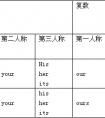下列各句均有一处错误,请找出并改正。1. Help yourself to some chicken, children. _____________________________2. He is very young,and he knows a lot. ________-八年级英语
themselves
考点名称:实义动词的过去式
- 表示一般过去式的动词通常用动词的过去式形式来表示,而动词的过去式是在动词原形的基础上变化的。
动词的过去式可分为规则动词和不规则动词。 实意动词过去式变化规则:
注:以l结尾的动词,尾音节重读时,双写l,如control—controlled;分类 构成 例句 一般情况下 在词尾直接加ed ask—asked
work—worked以不发音的e结尾 只加d love—loved
dance—danced
以辅音字母加y结尾 变y为i,再加-ed try—tried
study—studied以一个元音字母和一个辅音结尾的
重读音节结尾的动词先双写末尾一个字母,再加ed stop—stopped
permit—permitted“-ed”的读音规则 1.在清辅音后面读[t],如:help—helped[helpt]
2.在浊辅音或元音后读[d],如:learn—learned
3.在[t]和[d]后读[id],如:want—wantedneed—needed
尾音节不重读时,双不双写都可以,如travel—traveled/traveled。
特例:picnic—picnicked,另外还有很多动词的过去式是不合乎上述规则的,常见的有:
常用的有:
begin—began, bring—brought, come—came, draw—drew,
drink—drank, drive—drove, eat—ate, feel—felt,
get—got, give—gave, go—went, grow—grew,
have (has)—had, keep—kept, know—knew, leave—left,
make—made, read—read, run—ran, say—said,
see—saw, sit—sat几个特殊实意动词过去式用法:
a.beat的过去式与原形同形:
beat(打击)
beat(过去式)
beaten(过去分词)
b.lie有规则变化和不规则变化两种,含义不同
lie,lied, lied(说谎)
lay, lain(躺,位于)c.hang有规则变化和不规则变化两种,含义不同
hang,hanged, hanged(处绞刑)
hung, hung(挂,吊)d. welcome(欢迎)一词是规则动词,不可误用为不规则动词
welcome welcomed, welcomed(正)
welcome, welcome(误)e.不要将不规则动词误用为规则动词
hit(打)
hit, hit(正)
hitted, hitted(误)- 实意动词过去式用法基本句式:
1.主+V-ed+宾+其它。。。(肯定句)
2.主+didn't+V原+宾+其它。。。
3.Did+主+V原+宾+其它。。。+?
4.回答:Yes,主语代词+did\No,主语代词+didin't.
5.特殊疑问句:特殊疑问词+一般疑问句。 - 实义动词的一般过去时态:
肯定句要使用动词的过去式,否定句和疑问句要使用助动词do和 does 的过去式 did.
肯定句为:
主语+动词过去式+宾语 如:
I went home at nine o'clock yesterday.
否定句:
主语+didn't +动词原形+宾语 如:
I didn't go home yesterday. He didn't tell me about you.
疑问句:
一般疑问句:
Did +主语+动词原形+宾语
如:Did you go home yesterday?
Did you study in the school?
肯定回答: Yes, I did.
否定回答:No, I didn't.
特殊疑问句:特殊疑问词+did +主语+动词原型+宾语
When did you finish your homework last night?
What did you do the day before yesterday?
考点名称:并列连词
- 并列连词:
主要是用来表示并列关系、选择关系、因果推理关系等。也可用来连接平行的词,词组或分句。 并列连词表示关系及代表实例:
1.表示并列关系
表示并列关系的连词主要含有“和”、“补充”、“增加”等意思。用来表达并列关系的连词有如下几个:
and 和 both...and...二者都
either...or...或者...或者...
neither...nor...既不...也不...
as well as 也、连同
not only...but (also)... 不但...而且...
e.g.
I used to live in Paris and London.
我过去住在伦敦和巴黎。
Both Jane and Jim are interested in pop music.
詹妮和吉姆对流行音乐都很感兴趣。
She is not only kind but also honest.
她不但和蔼而且诚实。
Bob as well as his parents is going on holiday this summer.
鲍勃和他的父母今年夏天要去度假。
2.表示转折关系
常用来表示转折关系的并列连词有如下几个:
but 但是
yet 然而
still 仍然
while 然而
while 然而、偏偏
e.g.
The winter in Beijing is very cold while that of Kunming is warm.
北京的冬天很冷,然而昆明的冬天却很温暖。
I explained twice, still he counldn't understand.
我解释了两遍,然而他却还不懂。
3.表示选择关系
表示选择关系的并列连词:
or 或者
or else 否则
otherwise 否则
neither...nor... 既不...也不...
either...or... 或者...或者...
e.g.
Would you like leave or would you like to stay?
你是想走还是想留?
You can come either on Saturday or on Sunday.
你可以星期六来也可以星期天来。
Neither you nor I nor anyone else believes such things.
不管你我或者其他任何人都不会相信这件事。
4.表示因果推理关系
表示因果关系的并列连词主要有so,for,then,therefore 等。
e.g.
The air here is polluted, so the crops are dying.
这里的空气受到了污染,所以庄稼快死了。
The leaves of the trees are falling, for it's already autumn.
树叶在落下,因为秋天已经到来了。- 并列连词注意事项:
并列连词for引导的分句只能放在句尾,前面用逗号隔开,表示补充说明的微弱理由,只是为前面的内容提供判断的理由,有时译为并列的某种形式。
这与because不同,because引导的是一种明确的因果关系,解释原因,常可回答why的提问。 - 几个特殊并列连词用法:
一、表示并列关系的and,or,well,as,not only...but also... 等连词也有比较活跃的用法。
and 作为并列连词有多重含义,除了可以表示并列关系外,还可以表示顺承、目的、条件、反复等关系。
e.g:He went to market and bought some vegetables.(表示顺承,动作的先后发生)
他到市场买了一些蔬菜。
Come and help me out.(表示目的)
过来帮我一下。
Be careful and you'll make fewer mistakes.(表示条件)
如果仔细,你所犯的错就少。
二、or 与 either...or...
or表示为“否则”的话,前句一般是祈使句,后句用一般将来时。
在表示选择关系时or 与 either...or... 用法相同,但 either...or...更具强调性。
在多个对象进行选择时,可以用A or B or C... , either A or B or C... , neither A or B or C... 。
- 最新内容
- 相关内容
- 网友推荐
- 图文推荐
| [家长教育] 孩子为什么会和父母感情疏离? (2019-07-14) |
| [教师分享] 给远方姐姐的一封信 (2018-11-07) |
| [教师分享] 伸缩门 (2018-11-07) |
| [教师分享] 回家乡 (2018-11-07) |
| [教师分享] 是风味也是人间 (2018-11-07) |
| [教师分享] 一句格言的启示 (2018-11-07) |
| [教师分享] 无规矩不成方圆 (2018-11-07) |
| [教师分享] 第十届全国教育名家论坛有感(二) (2018-11-07) |
| [教师分享] 贪玩的小狗 (2018-11-07) |
| [教师分享] 未命名文章 (2018-11-07) |

![One of the climbers tried to pull ______up the rocks. Finally, he was lucky to get to the top. [ ]A. themselves B. himselfC. herself D. itself-八年级英语](http://www.00-edu.com/d/file/ks/4/2/fanshendaici/2019-12-01/small41ed7588e270175b6fd8ba260e900d321575203896.png)
![Sally buys a watch for father andasweater for_______.[ ]A. she; herselfB. her; herselfC. herself; herD. her; her-七年级英语](http://www.00-edu.com/d/file/ks/4/2/fanshendaici/2019-12-01/small3f1788cd5867bf4768797f36ec9e81961575203859.jpg)


![Don't lose ________ computer games, little boys! [ ]A. yourself toB. yourself in C. yourselves to D. yourselves in-八年级英语](http://www.00-edu.com/d/file/ks/4/2/fanshendaici/2019-12-01/smallce83f3a5e50b48d2e8ee989a20c11b101575203887.png)
